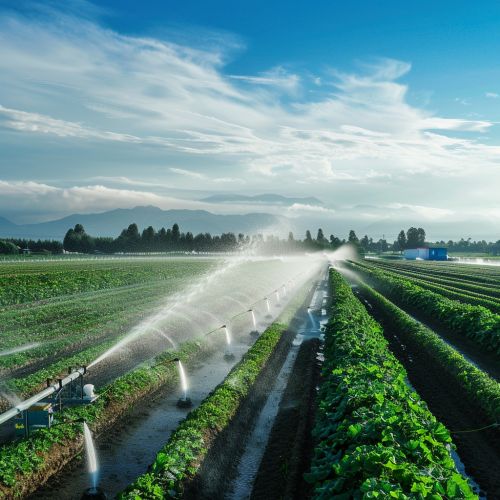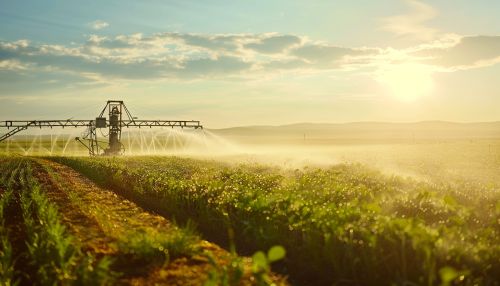Smart irrigation
Introduction
Smart irrigation is an advanced agricultural practice that leverages modern technology to optimize water usage for crop cultivation. This method integrates various technologies such as sensors, weather forecasts, and automated systems to ensure that plants receive the precise amount of water they need at the right time. Smart irrigation systems are designed to enhance water efficiency, reduce waste, and improve crop yields, making them a critical component in sustainable agriculture.
Components of Smart Irrigation Systems
Smart irrigation systems consist of several key components that work together to manage water usage effectively. These components include soil moisture sensors, weather stations, automated controllers, and irrigation valves.
Soil Moisture Sensors
Soil moisture sensors are devices that measure the water content in the soil. These sensors provide real-time data on soil moisture levels, which is crucial for determining the irrigation needs of crops. The data collected by soil moisture sensors can be used to adjust irrigation schedules and ensure that plants receive the optimal amount of water.
Weather Stations
Weather stations play a vital role in smart irrigation systems by providing accurate weather data, including temperature, humidity, wind speed, and precipitation. This information is used to predict water requirements and adjust irrigation schedules accordingly. By incorporating weather data, smart irrigation systems can prevent overwatering during rainy periods and ensure adequate watering during dry spells.
Automated Controllers
Automated controllers are the central units that manage the operation of smart irrigation systems. These controllers use data from soil moisture sensors and weather stations to determine the optimal irrigation schedule. Automated controllers can be programmed to operate irrigation valves at specific times, ensuring that water is delivered precisely when and where it is needed.
Irrigation Valves
Irrigation valves are devices that control the flow of water to different parts of the irrigation system. These valves can be operated manually or automatically by the automated controllers. In smart irrigation systems, irrigation valves are typically automated to ensure precise control over water distribution.


Benefits of Smart Irrigation
Smart irrigation offers numerous benefits over traditional irrigation methods. These benefits include improved water efficiency, reduced labor costs, enhanced crop yields, and environmental sustainability.
Water Efficiency
One of the primary advantages of smart irrigation is its ability to optimize water usage. By using real-time data from soil moisture sensors and weather stations, smart irrigation systems can deliver the exact amount of water needed by crops, reducing water waste and conserving valuable resources.
Reduced Labor Costs
Smart irrigation systems automate many of the tasks associated with traditional irrigation methods, such as monitoring soil moisture levels and adjusting irrigation schedules. This automation reduces the need for manual labor, resulting in lower labor costs for farmers.
Enhanced Crop Yields
By providing precise and timely irrigation, smart irrigation systems can improve crop health and productivity. Adequate and consistent water supply ensures that crops receive the necessary nutrients for growth, leading to higher yields and better quality produce.
Environmental Sustainability
Smart irrigation contributes to environmental sustainability by reducing water waste and minimizing the impact on natural water resources. Efficient water usage helps preserve water supplies for future generations and reduces the energy required for water pumping and distribution.
Challenges and Limitations
Despite its many benefits, smart irrigation also faces several challenges and limitations. These include high initial costs, technical complexity, and the need for reliable data sources.
High Initial Costs
The installation of smart irrigation systems can be expensive, particularly for small-scale farmers. The cost of sensors, automated controllers, and other components can be prohibitive, limiting the adoption of smart irrigation technologies.
Technical Complexity
Smart irrigation systems require a certain level of technical expertise to install, operate, and maintain. Farmers may need to undergo training to understand how to use these systems effectively, which can be a barrier to adoption.
Reliable Data Sources
The effectiveness of smart irrigation systems depends on the availability of accurate and reliable data from soil moisture sensors and weather stations. Inaccurate or inconsistent data can lead to suboptimal irrigation schedules and reduced system performance.
Future Trends in Smart Irrigation
The field of smart irrigation is continually evolving, with new technologies and innovations emerging to address existing challenges and improve system performance. Some of the future trends in smart irrigation include the integration of artificial intelligence (AI), the use of drones, and the development of more affordable and user-friendly systems.
Integration of Artificial Intelligence
Artificial intelligence has the potential to revolutionize smart irrigation by enabling more sophisticated data analysis and decision-making. AI algorithms can analyze large datasets from sensors and weather stations to identify patterns and optimize irrigation schedules. This integration can lead to even greater water efficiency and improved crop yields.
Use of Drones
Drones are increasingly being used in agriculture for various applications, including irrigation management. Equipped with sensors and cameras, drones can monitor crop health, soil moisture levels, and other parameters from the air. This aerial perspective provides valuable insights that can be used to fine-tune irrigation practices.
Affordable and User-Friendly Systems
To increase the adoption of smart irrigation technologies, there is a growing focus on developing more affordable and user-friendly systems. Advances in sensor technology and automation are driving down costs, making smart irrigation more accessible to small-scale farmers. Additionally, user-friendly interfaces and mobile applications are being developed to simplify system operation and management.
Conclusion
Smart irrigation represents a significant advancement in agricultural practices, offering numerous benefits in terms of water efficiency, labor cost reduction, crop yield enhancement, and environmental sustainability. While there are challenges to overcome, ongoing technological innovations and trends point to a promising future for smart irrigation systems. As these technologies continue to evolve, they will play an increasingly important role in ensuring sustainable and productive agriculture.
